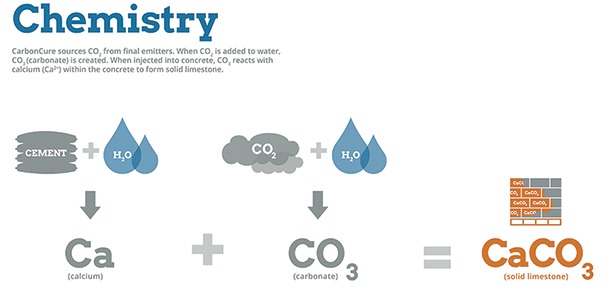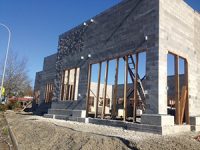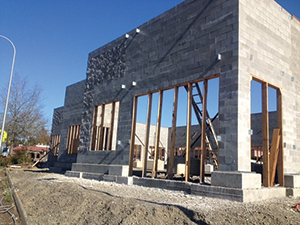Technology in Masonry
By Scott Biggar and Chelsea Code-McNeil
Advances in technology are self-perpetuating — conducting research and development inevitably leads to discoveries that propel innovation forward. CarbonCure Technologies is no stranger to this cycle. The company’s technology started when their CEO, Robert Niven, began researching the chemical reaction between carbon dioxide (CO2), cement and water while earning his master’s degree at McGill University in Montreal, Canada.
This research later became the foundation for CarbonCure’s development over the next eight years, and has transformed into what is now a viable solution for concrete producers to recycle waste CO2 in their concrete mixes.

Carbon dioxide, a known greenhouse gas and contributor to climate change, is quickly becoming a major topic for the construction industry. Architects and developers have been refining building systems and techniques for decades to help mitigate CO2 emissions associated with their buildings. Yet this approach addresses only one end of the smokestack, and new technologies are being developed to make use of CO2 to produce new building materials.
The fundamentals of CarbonCure’s technology hinge on the chemical reaction referred to as mineralization. The reaction occurs when CO2 is injected during the manufacturing process of concrete masonry units (CMUs). The CO2 gas reacts with calcium ions found in cement and undergoes a reverse calcination reaction (Fig. 1), resulting in the formation of a calcium carbonate mineral (limestone).
A CMU that arrives on-site made with CarbonCure’s technology has exactly the same physical properties and appearance as a traditional CMU. The difference is that a CarbonCure CMU has taken CO2 and trapped it inside, where it can no longer be released. Since the gas has been converted to calcium carbonate, it is no longer a contributor to climate change.
Designers and architects are constantly being asked to prioritize material properties to stay functionally true to the motivations of their clients. When considering the use of CMUs on a project, a lot of properties stack up in the materials’ favor: durability, strength, fire resistance and thermal mass. All of these material properties contribute to a building’s resiliency, and with the onset of LEED v4, new measures are being put in place to reward materials that can withstand climate impacts.
Despite the material benefits of masonry, there is one ingredient in a CMU that carries a heavy carbon footprint: cement. The construction industry has been aware of cement production’s CO2 emissions for many years now, and has been pushing manufacturers to find solutions for reducing this footprint.
Where some see CO2 from concrete as a problem, CarbonCure sees it as an opportunity for adaptive reuse. Every block is an opportunity to store a small amount of carbon, a chance to shave some of the cement industry’s emissions off the top and put it back into the concrete.
Brampton Brick, a masonry producer with operations across southern Ontario, was one of the first adopter’s of CarbonCure’s technology in North America, first partnering with the company in 2013. In September 2015, Brampton made the decision to install the technology at two more of its plants, citing the desire to start manufacturing all of its products with recycled CO2.
“Everything we manufacture today now has CO2 in it,” said Dave Carter, CEO of Brampton Brick. He points to green building standards such as LEED as drivers of the trend.

(Courtesy of CarbonCure Technologies)
Using CMU as a vessel for storing carbon didn’t add a lot to Brampton Brick’s overall costs, nor did it alter their production practices. But Carter doesn’t tout his company’s CO2-injected blocks as a silver bullet for the concrete industry.
“It’s just a piece of the puzzle,” he said, pointing also to the cement and concrete industry’s rising use of alternative fuels and materials.
The addition of CarbonCure in the mix design has no impact on CMU weight, color or ASTM requirements. Since 2013, CarbonCure has installed its technology at 22 plants across the U.S. and Canada.
Developers and architects across the U.S. are starting learn about the prospect of storing carbon in concrete block. Kimco Realty, North America’s largest owner and operator of open-air shopping centers, recently constructed the first project in Oregon to use CarbonCure block. The block was manufactured and supplied by Mutual Materials, a recent CarbonCure partner.
|
|
|
|
“Adding CarbonCure onto our Sunset Mall project was fairly seamless,” said Tim Hamann, director of construction at Kimco Realty.
The new mall outlet will be home to two restaurants and a retail shop, with construction being managed by Lanphere Construction and Development.
“Our general contractor and masons didn’t have any issues with the block,” said Hamann. “The project was installed the same as regular masonry. Recycling CO2 on this project was just something that aligned with Kimco’s sustainability goals.”
The integration of CarbonCure’s technology into a block plant is also very simple. Once a producer has established a supply of locally sourced industrial CO2, CarbonCure’s engineers install their equipment and work with the plant’s quality control team to integrate the CO2 into their concrete mixes.
In an era where innovation is crucial for both the environment and the sustainability of an industry, concrete producers are seeking ways to improve both their manufacturing processes and their company branding. The addition of CarbonCure’s technology provides a small but innovative tweak to existing plant operations, while helping to answer a global cry for carbon storage solutions.
For more information on CarbonCure’s technology, contact Christie Gamble, director of sales and marketing, at cgamble@carboncure.com.
Scott Biggar is sustainability manager and Chelsea Code-McNeil is sustainability coordinator for CarbonCure Technologies.


